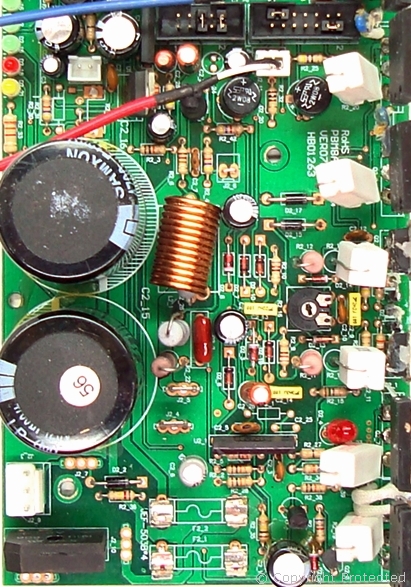Power Resistor
A power resistor is a special resistor, which dissipates a large amount of electrical power in watts. The resistor design is such that it can withstand high temperatures and dissipate the heat quickly therefore, these resistors are usually larger. As a general rule of thumb, a larger power rating implies a larger package size.
Applications
Heavily used with valve technology such as televisions and radios, the modern applications tend to be high-end amplifiers, power supply circuits, and industrial power systems.
Power Dissipation
Power dissipation is calculated by the simple formula P = I × V, where "P" is the power in watts, "I" is the current passing through the resistor, and V is the voltage across it.
The alternative formula is the famous P = I² × R, where "P" is the power the resistor dissipates, "I" is the current flowing through it, and "R" is its resistance.
Absorption / Dissipation
All resistors absorb power and those in low voltage bias and signal applications usually absorb negligible amounts, hence they usually have a ¼-watt power rating and metal film composition. However, resistors that have to dissipate larger amounts of power are usually much larger and made of other materials that can handle high temperatures.
When a resistor operates beyond its power rating, it usually heats and goes open; however, it may cause a hole in the PCB before it goes open, which is why their long leads have them floating above the PCB.
Resistor Materials
A typical power resistor tends to be wire-wound, and housed in an aluminium package with a chassis-mounting flange. These types usually require mounting to a chassis to drive away and disperse the heat, and are therefore more expensive and used in high-end amplifiers.
SBC Square Ceramic

The square ceramic resistor is one of the most commonly used ones in amplifiers. These usually connect between the emitter and ground, or emitter and a power rail, and tend to be low resistance values.
Ceramic resistors tend to be wire-wound providing high power ratings. These resistors are fusible and go open when overloaded, and being ceramic, they tend to be non-flammable; however, they can have a surface temperature reaching well over +350 °C.
For the Alto PBM8 500, I replaced the following 0.1 Ω 3-watt resistors with ceramic 5-watt resistors.
- R2_20, R2_24, R2_19, R2_23, R1_20, R1_24, R1_19, R1_23
I also replaced the following 22 Ω 2-watt resistors with 3-watt ceramic resistors.
- R2_13, R2_14, R1_13, R1_14
Finally, for the cherry on the cake, I replaced R1_22 and R2_22 on the final output stage with 10 Ω 3-watt ceramic resistors.
Installation and Soldering

These ceramic resistors mount vertically on the PCB, and hover above it as they heat up substantially.
In this photograph, you can see the new higher wattage resistors installed. I soldered them at an angle to keep a large distance from other components. Placing them vertically and above the PCB is probably the best way to install them. The 22 Ω 3-watt resistors near the MJE pair are a tight squeeze, but there is plenty of space there as you can see.
I hope that these will be able to take the load for a few more years than the previous ones, and more importantly, Father Clark will not knock on my door again. The last I heard he was saying that his sonorous voice was sounding even more booming through the amp.
This Article Continues...
PBM8 500 MKIIPBM8 500 MKII Inside Look
PBM8 500 MKII Diagnostic Logic
PBM8 500 MKII Fault Solved!
Power Resistor
Amplifier Heat Sink
Class AB Amplifier
How to Check Transistors
GCA5200T and GCA1943T Transistors
2SC5200 2SA1943 Transistor Replacement
PBM8 500 MKII Diagnostic LEDs
PBM8 500 MKII Power Supply